Hand-to-hand fight: the secret weapon of the Red Army
At the same time story The bayonet in the Russian army began long before World War II. It originates from the time of Peter I. The introduction of the bayonet instead of the baginet in 1709 made the gun quite suitable for action in battle not only with fire and butt, but also with a bayonet. Unlike baginet, the bayonet did not have to be separated from the gun before each new shot and during the loading process. Combining the bayonet with a gun significantly increased the offensive power of the Russian infantryman. Unlike the armies of European countries in which the bayonet was used as a defensive weapon, in the Russian army it was used as an offensive weapon. A strong bayonet strike became an integral part of the tactics of the Russian army. Over time, the Russian method of conducting a bayonet battle so intimidated the enemy that, according to the Geneva Convention, the traditional strike in the stomach was replaced with a “more humane” strike with a bayonet in the chest.
Officially obligatory classes in gymnastics and knife fights began in the Red Army as early as 1918, they were combined with mandatory exercises on shooting. Hand-to-hand combat in the army necessarily included combat gymnastics — various movements with weapons, shovels, and somersaults, as well as overcoming various obstacles. During the years of the civil war, they managed to accumulate a great deal of hand-to-hand fighting, based on this experience, further development of hand-to-hand combat in the USSR proceeded. Beginning with the 1924 year, the first official military manuals for physical training of fighters and citizens of pre-conscription age began to be published in the country.
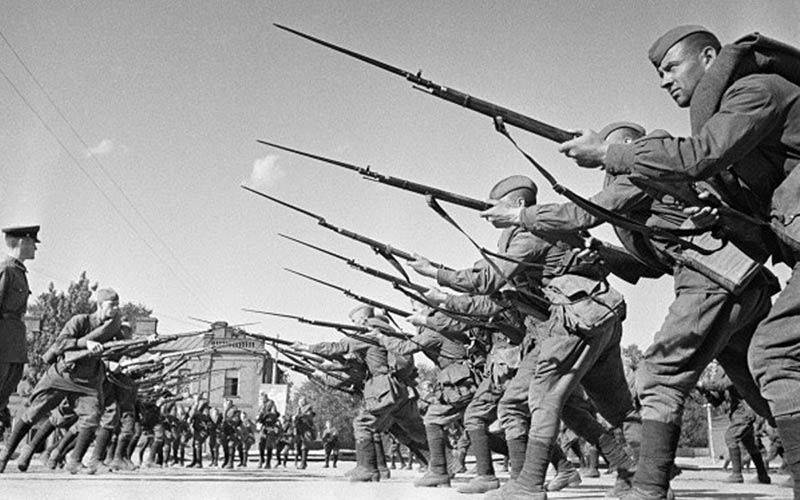
Before the start of World War II, the army managed to undergo a sufficient number of reforms that significantly changed the principles of hand-to-hand combat. Bayonet fighting, throwing grenades and shooting were combined into a single complex. Great lessons were learned from military conflicts with Japan and Finland. The experience gained by the Red Army proved that the bayonet battle, or, at any rate, its readiness for it, was still the decisive and final element of any attack. This experience clearly showed significant losses in melee fights both because of the competent use of the bayonet, and because of the inability to use it.
In the USSR, it was understood that hand-to-hand combat, night combat, reconnaissance actions, a combination of grenade strikes and cold weapons - all this created an environment that requires the necessary peacetime training for any army that wants to secure victory in future battles and achieve it. little blood. The combat regulations of the infantry of the Red Army before the war was quite categorical: “The ultimate combat task of an infantryman in an offensive battle is to smash the enemy in a melee.”
The Red Army soldiers were constantly taught that their bayonet was an offensive weapon, and the very essence of a bayonet battle was interpreted as follows: “The experience of wars shows us that a large number of soldiers were killed or wounded only because they could not use their weapons properly, especially bayonet. At the same time, bayonet combat is a decisive factor in any attack. Until the last opportunity, bayonet fighting is preceded by shooting. At the same time, the bayonet is the main weapon in the night battle. ” The soldiers of the Red Army were taught that during the hand-to-hand combat of the retreating enemies, they should push the bayonet and hand grenades all the way to the line indicated in the order. A chasing an opponent to pursue fast, accurate and calm fire.
In the Red Army a lot of attention was paid to the speed with which the fighters could move, and their sharpness was developed with the help of fast games and various physical exercises that required instant muscle response and high speed of thinking. At the same time, boxing and sambo played a significant role in the development of the individual qualities of the fighters, and they went hand in hand with the basics of bayonet fighting.
Harsh School of War
The Finnish war proved the importance of studying hand-to-hand combat techniques, and battles with fascist troops, especially battles in cities and trench battles, summed up this experience and greatly enhanced. Lieutenant-General Gerasimov thus described the tactics of assault on the enemy's fortified areas of defense: “From a distance of 40-50 meters, the attacking infantry must cease fire in order to reach enemy trenches with one decisive throw. From a distance of 20-25 meters, hand grenades come into action, which soldiers throw on the run. This is followed by a shot at close range and the defeat of the enemy with the help of knives ”.
The catastrophic start of the war and the 1941 boilers of the year led to substantial losses in the ranks of the Red Army. But already in those difficult months of the war the strengths of the Soviet armed forces became clear. It was possible to establish that in hand-to-hand combat, the Wehrmacht’s soldiers were inferior in level to the Red Army. Thus, the arguments that boiled before the start of the war that the bayonet had already lost its relevance demonstrated the correctness of those military specialists who insisted on mass training of soldiers in bayonet combat skills.
Today in the newsreel footage of those years, you can see how the militiamen teach you to prick the enemy with bayonets while on the run, but in the first months of the war, you had to destroy the Nazi invaders in other conditions - in your own or others' trenches, trying to deliver an accurate blow to the neck. At the same time, the sapper shovel became the most formidable weapon of the Soviet fighters. Especially well these improvised weapons were owned by builders and numerous collective farmers who had joined the Red Army and who often had to work as carpentry axes before the start of the war. Their blows were sharp and sometimes of such strength that they could chop off limbs, not to mention broken heads. After the hand-to-hand fighting, the funeral German teams often found their soldiers with their skulls cut.
Remembering the campaigns in Europe, the soldiers and officers of the Wehrmacht, more and more often in conversations among themselves and in their letters to their homeland, expressed the thought: "Whoever did not fight in the Russian melee, he did not see a real war." Artillery fire, bombardment, firefight, hunger and cold, exhausting marches in the mud could not be compared with the fierce and short bouts in which it was very difficult to survive.
“We fought for one house for 15 days, using mortars, machine guns, grenades, and bayonets,” wrote the German lieutenant of the 24th tank divisions in his letter home about the battles in Stalingrad. - Already on the third day of fighting in the stairwells, stairs and basements, we left the corpses of 54 of my comrades. The "Front Line" in this war went along the corridor that separated the burnt rooms, along the ceiling between floors. Reinforcements pulled up to us through the fire escape, chimneys, from neighboring buildings. At the same time, the struggle went from morning to night. From one floor to another, with blackened soot, we throw grenades at each other, fighting in the thunder of explosions, puffs of smoke and dust, among puddles of blood, piles of cement, pieces of furniture and fragments of human bodies. Ask any fighter what half an hour in hand-to-hand combat means in such a fight. And then imagine Stalingrad. 80 days and 80 nights of hand-to-hand fighting. In which the length of the street is now measured not by meters, but by dead bodies. ”
Basic techniques of bayonet combat
The following main methods of bayonet fighting were practiced in the Red Army: a shot, a butt and a kick.
An injection
The injection, of course, was the main method of the bayonet battle of the Red Army. The highlight of the bayonet battle was striving straight at the enemy's rifle with a bayonet, threatening his throat and hitting the open space of the body. To perform an injection, it was necessary to send a rifle (carbine) with both hands forward (having pointed the point of the bayonet at the target) and, fully straightening the left hand, advance the weapon with the right hand across the palm of the left hand until the magazine box rests on the palm. At the same time, it was necessary to sharply straighten the right leg and, giving the body forward, apply a shot with a lunge of the left leg. After that, it was necessary to immediately pull out the bayonet and take the starting position.
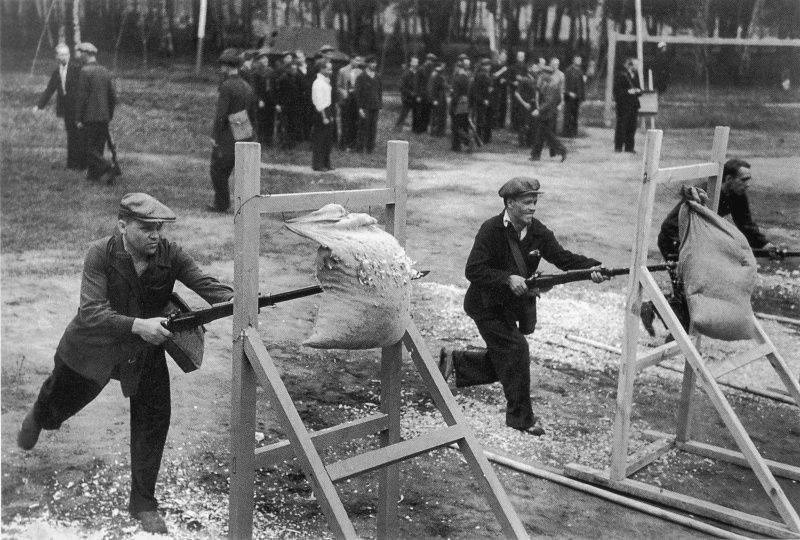
Depending on the combat circumstances, an injection could be inflicted both without deception and with deception of the enemy. In those cases when the enemy’s weapon didn’t prevent the injection, it was necessary to prick straight (injection without cheating). And when the enemy was covered with his own weapon, then, sending the bayonet directly, it was necessary to create a threat of an injection (deception), and when the enemy attempted to make a beating, quickly transfer his bayonet to the other side of the enemy's weapon and stab him. At the same time, it was always necessary to keep his opponent under attack, as a soldier who could not deliver a sensitive blow to the open space of his opponent's body for even just one fifth of a second, himself risked being killed.
Mastering the injection technique by the Red Army was carried out in the following sequence: first, the injection was performed without the stuffed animal; after this injection in the effigy; then a shot with a step forward and lunge; prick in motion, step and run; injecting a group of stuffed animals with a change in direction of movement; at the end, the fighters practiced an injection of stuffed animals in various settings (trenches, trenches, forest areas, etc.).
When training and studying the injection, the focus was on the development of strength and accuracy. As part of the study, the soldiers of the Red Army literally memorized the dictum of Russian General Dragomirov: “It must always be remembered that when using cold weapons, the eye meter is undoubtedly more important than in firing: there is an infidelity of the hand or an error in determining the distance to the target leads to loss of a bullet here it can lead to the loss of life. ”
Kick butt
The soldiers had to use the butt strikes, if they met their opponent closely, when it was already impossible to inject him. In this case, the blows could be applied from the side, top, front and back. In order to strike at the enemy from the side, it was necessary to simultaneously strike the right foot forward and move the right hand from the bottom up to deliver a strong blow with an acute butt to the head area of the enemy soldier. A side butt kick could be conveniently applied after performing a beating to the left.
For striking the butt forward, it was necessary to push the butt down with the right hand and, having seized the right arm above the top lying ring, pull back his rifle or carbine, carry out the swing, then hit the enemy with the left foot, the back of the butt.
To strike with the butt back, it was necessary to turn on the heels of both legs to the right in a circle (at the same time the legs in the knees did not unbend), at the same time it was necessary to make a swing, for this it was necessary to take the rifle or carbine back as far as possible, turning it with a magazine box upwards . After that, with a lunge of the right leg, it was necessary to carry out a blow with the back of the head of the butt on the enemy’s face.
In order to strike a butt from the top, it was necessary to throw the weapon up, turning it with the magazine upwards, on the fly grab it with the left hand from the top of the upper bed ring, and with the right hand from the bottom of the lower bed ring and with a lunge with the right foot strike a strong blow from above with a sharp corner .
At the same time, it was necessary to strike blows with a butt quickly, accurately and strongly. Training of these blows was carried out on stuffed sheaves or on a training stick ball.
Chipping
Repulses were used by Red Army soldiers to protect against enemy pricks during an attack, when a weapon in the hands of the enemy prevented an injection. After beating the blow of the enemy, it was necessary to immediately take a shot or to perform a blow with a butt. Repulses were performed right, left and down right. Fighting back to the right side was carried out when an enemy soldier threatened to stab into the upper right part of the body. In such a situation, with a quick movement of the left hand to the right and slightly forward, it was necessary to make a short and sharp blow with the forearm on the enemy weapon and immediately make an injection. To carry out having beaten down to the right (when the enemy attempted to prick the lower part of the body), it was necessary to quickly move his left hand in a semicircle to the left and down to the right to make a sharp blow with the forearm on the rifle of the enemy.
Repulses were performed with one hand, they were performed quickly and on a small scale, without turning the hull. The sweeping repulse was unfavorable for the reason that the soldier opened himself, giving the opportunity to inflict an injection on the enemy. First, there was a study of only the techniques of the beats, after which he studied by beating to the right with a prick with a training stick and having beaten off with the subsequent execution of the injection into the effigy. After this training began to be carried out in a complicated and varied environment in combination with pricks and butts.
During the Great Patriotic War, a huge number of melee fights took place. It was a vital necessity. At the same time, the statistics clearly show that in the majority of melee fights the initiators were the fighters and commanders of the Red Army. According to statistics, the opponents of the Red Army decided to fight hand-to-hand only in 29% of cases, which indicates their fear of this type of battle, while the Red Army fighters, on the contrary, sought to impose hand-to-hand combat on the enemy.
Information sources:
http://weapon.at.ua/publ/20-1-0-330
http://svpressa.ru/post/article/109070/?rintr=1
http://ammoussr.ru/history/rukopashnyiy-boy-v-krasnoy-armii
http://protectyou.ru/articles/rukopashnyy-boy-v-krasnoy-armii
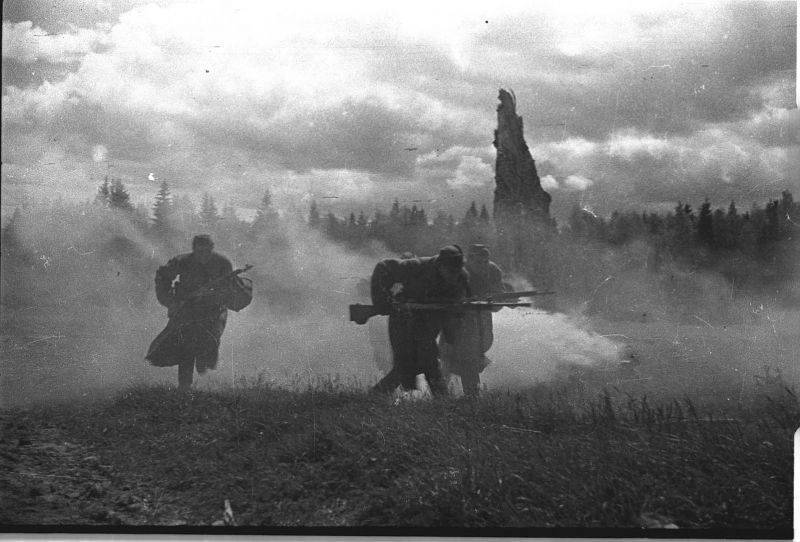
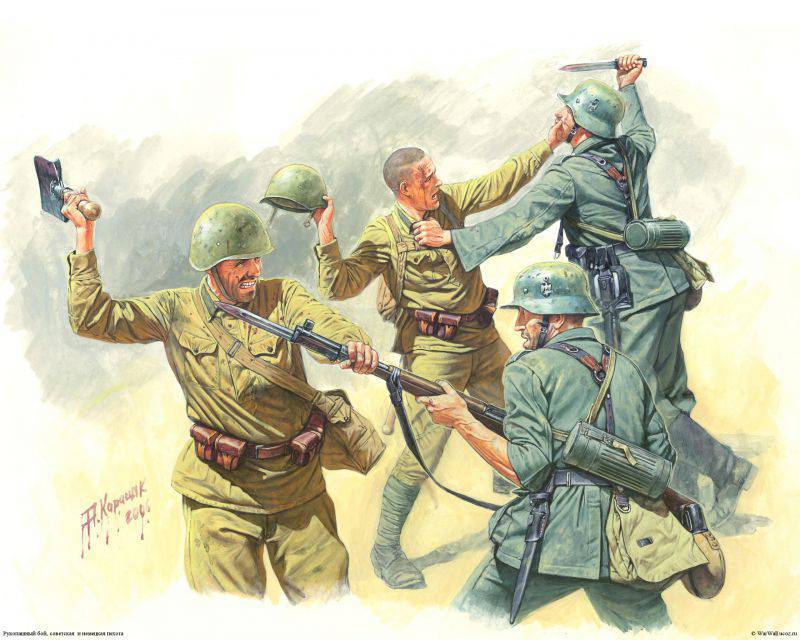
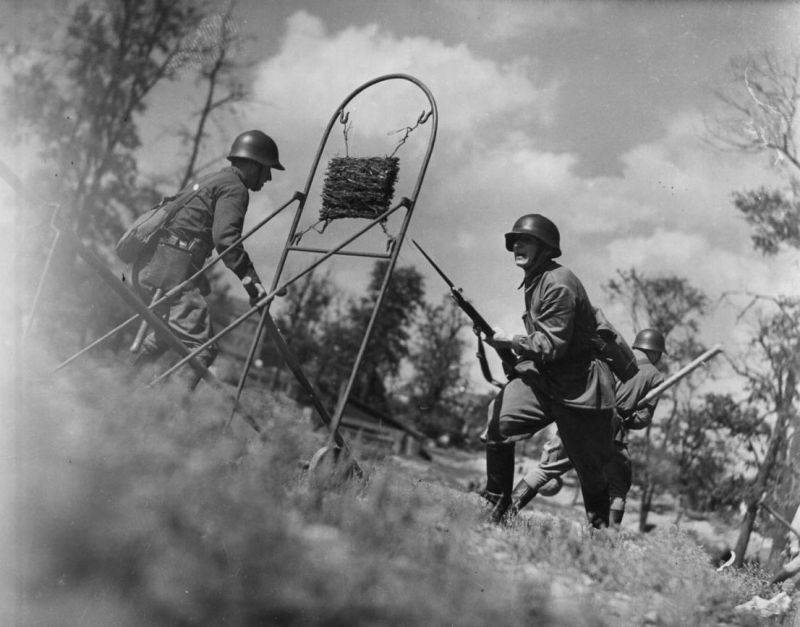
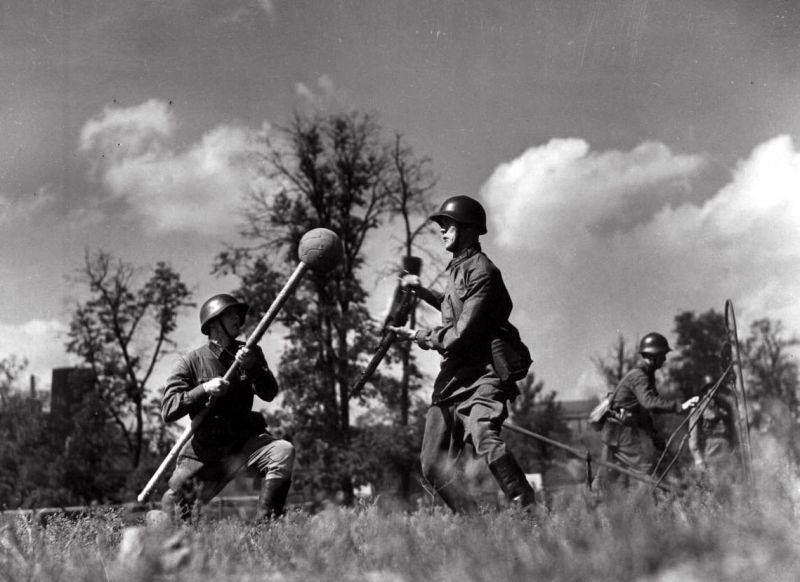
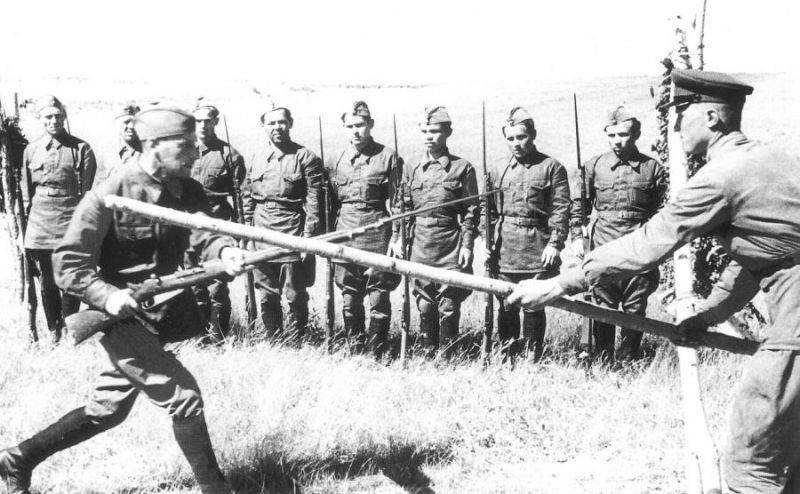
Information